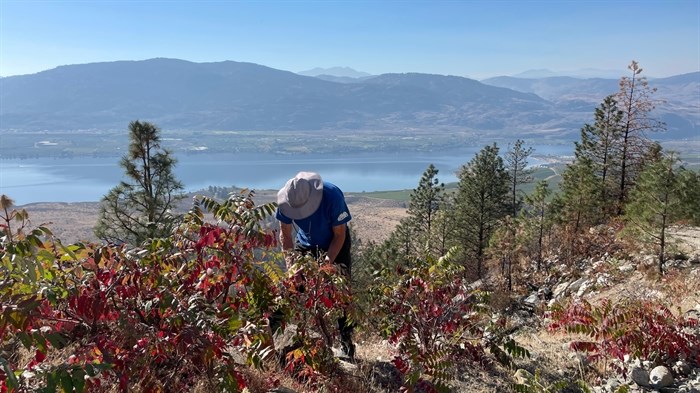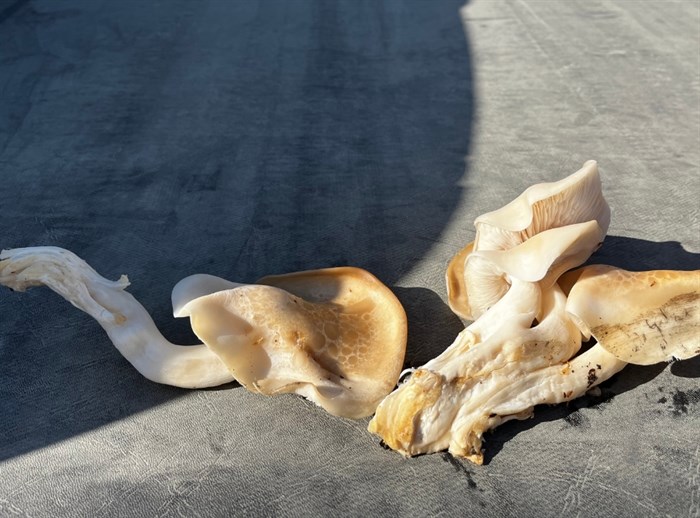
A man collects Sumac seeds in Oliver in this undated photograph.
Image Credit: SUBMITTED/ Siya Forestry
May 18, 2025 - 6:00 AM
A cutting-edge initiative in the South Okanagan aims to add commercial value to natural forest resources beyond harvestable timber.
Led by the Osoyoos Indian Band, the project focuses on non-timber forest products, including wild mushrooms, berries and barks that hold cultural, medicinal and potentially economic value.
“We always have a longer vision of where we can go with something,” said Forestry Manager with OIB, Dan Macmaster. “Is there something we can build off from a commercial point of view to bring out these non-timber products that are more than just logs? That’s the real push.”
Finding a way to commercialize non timber resources could revitalize Indigenous cultural practices and shape the way to increasing biodiversity in traditional methods of forest management.
It has the potential to become a sustainable model for other areas in the province.
"We're laying the foundation for something long term and are already getting interest from other First Nations," Macmaster said.

These unidentified mushrooms were foraged in the South Okanagan
Image Credit: SUBMITTED/ Siya Forestry
The project was launched by Vincent Dufour, a registered professional forester with Siya Forestry.
Dufour is working alongside community members to tackle the mega task of gathering an inventory of non timber products across the OIB traditional territory extending from South Okanagan to the West Kootenays.
“We are learning a lot from the Elders and knowledge keepers and the project has been well received, there’s a lot of interest in it,” he said.
The group is mapping out where different species grow and at what seasons, and identifying sensitive ecosystems. They have catalogued more than 160 non timber products with traditional or commercial value.
There is potential for economic development around mushrooms and herbal plants. All steps in the process are taken with sustainability and cultural protocols in mind in order to avoid overharvesting or disrupting the ecosystem.
The project is happening on land licensed by the Osoyoos Indian Band. One challenge of the project is the lack of clear legislation around harvesting and commercial use of these products in BC.
“There aren’t a lot of regulations out there outside of logs, and not that I want rules involved but it’s a bit of a free-for-all,” Macmaster said. “I think there’s an opportunity to manage based on a site-specific product that could be brought to market, and it really needs to go through the First Nation with the license.”
READ MORE: Without explanation province wipes CN Rail's $2.7M fine for starting BC wildfire
Another challenge is getting the necessary funding for infrastructure like processing, storage and distribution systems.
There is always an element of economics involved and the project has required funding from The BC Indigenous Forest Bioeconomy Program to get started.
“Funding is critical overall, our funding source was important and hopefully there’ll be future opportunities from the ministry of forests for funding and support.
“In order to bring back a classic harvest block you could do some selective harvesting but you still want to bring back critical plants and bushes for ecological and maybe a berry picking value. The money to do that would have to come from log sales because there is no other revenue being generated.”
READ MORE: Second First Nation files dispute over Highland Valley mine expansion
Macmaster has been working with Dufour on multiple projects looking at new ideas for sustainable silviculture practices and studies that focus on how the land recovers from disturbances like logging or wildfire.
“Traditionally on Crown land we’re planting crop trees and we have to meet legal obligations, make sure the trees are growing and the next rotation is good, but silviculture is about turning management into what’s best for the land,” Macmaster said.
“Trees are one component, but shrubs, plants, water and wildlife need to be looked at when coming up with a plan.”
Macmaster said that premise is what the band has been voicing for a few years, and Dufour took hold of it.
“I thought we could do more than just order some trees and put them in the ground,” Dufour said. “I pursued the band to work with us to establish non-timber forest product activities and look for commercialization potential. We could also create jobs and a dynamic between forest activities and the band.
“This doesn’t exist in BC but maybe we can create it and find a niche while helping restore some traditional values.”
READ MORE: iN PHOTOS: This South Okanagan gem a must-see for birders, outdoor enthusiasts
When it comes to communication with community and having Elders involved, Macmaster said relationships with the First Nations always moved at the speed of trust, and moving too quickly can become overwhelming.
“We want to make sure we have accurate information and move in the different directions the band wants to see. So far, it has been supportive, we’re looking at the holistic approach of the forest, that's more than just timber.”
Established in February 2024, Siya Forestry is a joint venture between Nk'Mip Forestry LLP of the Osoyoos Indian Band and Infinity-Pacific Stewardship Group Ltd., dedicated to advancing forestry practices and supporting community development in the Okanagan, Kootenay, and Boundary regions.
To contact a reporter for this story, email Shannon Ainslie or call 250-819-6089 or email the editor. You can also submit photos, videos or news tips to the newsroom and be entered to win a monthly prize draw.
We welcome your comments and opinions on our stories but play nice. We won't censor or delete comments unless they contain off-topic statements or links, unnecessary vulgarity, false facts, spam or obviously fake profiles. If you have any concerns about what you see in comments, email the editor in the link above. SUBSCRIBE to our awesome newsletter here.
News from © iNFOnews, 2025